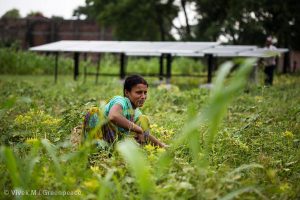India will need over USD 1 trillion from now until 2030 to adapt to the adverse impacts of climate change, according to a joint study by the Indian Institute of Management (IIM) Ahmedabad, the Indian Institute of Technology (IIT) Gandhinagar and the New Delhi-based think tank Council on Energy, Environment and Water (CEEW). The study identifies India’s preliminary financial, technology, and knowledge gaps in adaptation, as well as capacity building and institutional needs.
Adaptation to the impacts of climate change is a key component of the negotiations currently ongoing in Paris, where 195 countries and the European Union are trying to work out a new pact to combat global warming.
In 2012 the Indian Ministry of Finance had estimated that the country was spending 2.6% of its GDP on dealing with an increased severity and frequency of storms, floods and droughts, as well as reduced agricultural output, glacier retreat in the Himalayas and a rise in sea level along its 7,500-kilometre coastline. The new study, conducted by Amit Garg of IIM Ahmedabad, Vimal Mishra of IIT Gandhinagar and Hem Dholakia of CEEW estimates that around 800 million people living in 450 districts in India are now experiencing significant increases in annual mean temperature – above the two-degree Celsius ceiling agreed upon by governments for the rest of the century.
The authors say that India as a whole will experience 1-1.5 degrees Celsius increase in mean annual air temperature from 2016 to 2045, which could have profound implications for agriculture. These effects could be further pronounced given the estimated increase in heavy rainfall and snowfall events, resulting in flooding and damage to infrastructure.
Government spending on developing capacity and adaptation in India has grown over the last decade and USD 91.8 billion was spent on adaptation in 2013-14 alone, according to the authors. But this spending will have to reach USD 360 billion (in 2005 prices) by 2030. In addition, the loss and damage from extreme weather events were estimated at USD 5-6 billion per annum.
Commenting on the study, Ashok Lavasa, Secretary, Ministry of Environment, Forest and Climate Change, said, “Supporting and enhancing the sustainable development of 1.25 billion people is at the heart of India’s adaptation gap filling strategy. The fruits of development should not be lost due to increasing adaptation gap in the future.”
India’s Intended Nationally Determined Contribution (INDC) submitted to the UN Framework Convention on Climate Change (UNFCCC) in early October reiterated the need for better adaptation by enhancing investments in sectors vulnerable to climate change, particularly agriculture, water resources, health and disaster management. In terms of geography, the INDC as well as the authors have emphasised the need to concentrate on the Himalayas and the coastal areas.
 The study was done by IIM Ahmedabad, IIT Gandhinagar and CEEW.
The study was done by IIM Ahmedabad, IIT Gandhinagar and CEEW.


